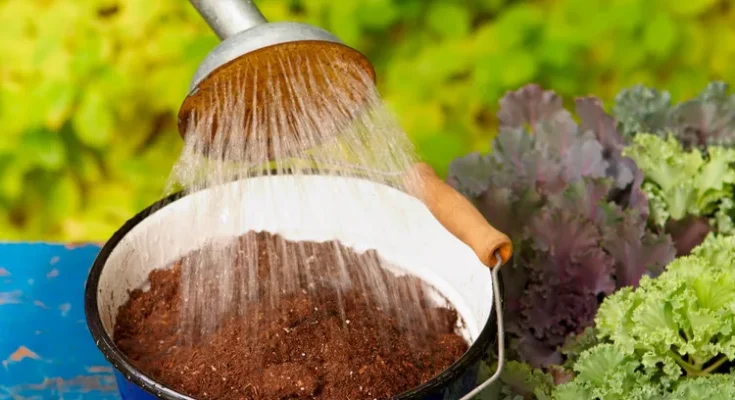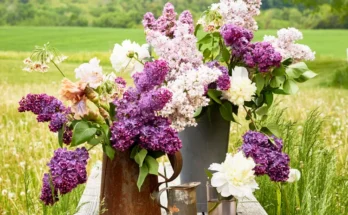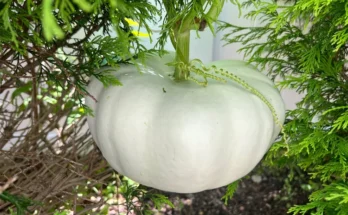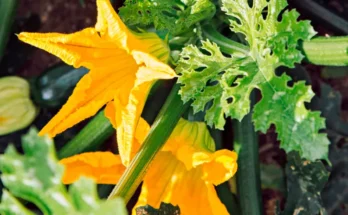Rehydrate dried out potting soil with these simple methods to keep your plants thriving.
We’ve all been there. A few too many skipped waterings and your plant is wilting or dropping leaves. You try watering and the water sheds right off the top of the soil, which has turned hard and crusty. Or you discovered some old, bagged soil (yay!) but it’s as dry as dust and won’t absorb water very easily. What to do? Soak in these tips on rehydrating your potting soil for both indoor and outdoor plants.
What Dries Out Potting Soil?
There are several factors affecting the moisture level in your potting soil, such as the quantity of moisture applied to it, certain environmental conditions, and the type of components in the potting soil.
Amount of Watering
The most obvious factor is the amount and frequency of water the plant receives, via watering can or the rain. Humidity and ambient temperatures play a crucial role here in how quickly water dries out of potting soil.
Environmental Conditions
Heat and dryness will both exacerbate water evaporation. Other environmental elements to consider include direct afternoon sun, hot or cold air (whether from outdoors or from an air-conditioning or heating vent), and heat from a heater or fireplace which dry soils out faster too.
Type of Potting Soil
Different potting media have different water-holding abilities. For example, soils marketed for cacti and succulents are highly porous, designed to drain water away quickly from the moisture-sensitive roots of desert plants. Orchid media typically includes lots of bark to maintain air pockets around the roots. Standard potting soils (which generally resemble crumbly chocolate cake) aim to retain water while including vermiculite or perlite to increase drainage and air space.
Signs of Dryness
The first sign you’ll see in potting soil or mix is a change in color. If instead of rich ebony or chocolate, the media turns a wan gray brown, it’s lost significant moisture. Then try the heft test. Compare the weight of the pot just after watering to the weight when it’s dried out. Really dry pots significantly less than well-watered pots.
Next the soil begins contracting and pulling away from the sides of your container. In the advanced stage, when the top of the soil becomes rigid and hard to penetrate, the media has become hydrophobic; it literally repels water.
This problem is easy to miss. You’ll see water running out of the drainage hole in the pot’s base, but instead of saturating the soil, it’s bypassing it completely through the gaps on the sides. So, you can be watering for days or weeks without the plant receiving a drop.
The soil components are another issue. Peat moss, although its sustainability is under challenge now, is popular for its moisture-holding power. However, once it dries out, it resists absorbing water.
:strip_icc():format(webp)/BHG-Rehydrate-Potting-Soil-BOXxVtXF4MBAbL-ug8E6Dh-eaf6736295404a2da95ee107bac2c081.jpg)
Ways to Rehydrate Potting Soil
Getting dried out potting soil to absorb water again can take some patience. Here are the best methods to successfully rehydrate your mix.
Submersion
For a potted plant, your best strategy at this point is to saturate the entire pot following these steps:
- Fill a tall bucket with water, taller than the height of the pot.
- Immerse the pot. Hold it down to keep it from floating.
- Air bubbles will begin forming at the top as the water displaces the air pockets in the soil so hold the pot under the water until they stop completely.
Bottom-watering
A less drastic option is to let water soak up gradually from the bottom. This is also known as “bottom watering.” Sit the pot in a shallow container, like a saucer or bin filled with several inches of water.
Take care not to overdo this, especially with plants that need excellent drainage, like succulents, Mediterranean woody herbs, or orchids. Don’t leave them soaking longer than an hour or two, and check that the pot feels heavy and full. Test the moisture level from the top with your finger, going an inch down. If wet soil sticks to your fingers, the water has reached that far.
Trickle and Poke
For containers that are tough to lift, try watering from the top a little at a time. Let water slowly trickle so it can be absorbed before shedding off the sides. You can poke a few holes in the soil with a fork or pencil to help this process along.
Slowly Mixing
When it comes to that old bag of dried out potting soil you found, you’ll want to likewise go slowly to rehydrate it back to working order. Like mixing the wet and dry ingredients in pancake batter, add small amounts of water in increments and mix thoroughly with a trowel or your hands. Don’t add too much water; your final product should be the texture of a wrung-out sponge.
Once you’ve rehydrated your potting mix or soil, you should be able to return to a regular watering schedule. The trick is in keeping that consistent.
Keeping Potting Soil Hydrated
Potting mixes become hydrophobic when the lack of moisture has reached a critical point. To avoid the stress on your plants (and you!), consider these steps to preserve adequate hydration for your potted plants:
Retain Existing Moisture
Mulch the surface of the soil to prevent evaporation (for indoor plants, use fresh bagged mulch or gravel; garden materials could bring unwanted pests).
Boost Humidity
Cluster plants together to raise local humidity. Add humidity trays filled with water and pebbles underneath pots. Note that the water level should not touch the pot’s drainage hole. This would allow the water to wick up 24/7, which is too much for many plants to handle.
Water Consistently
Establish a watering routine or use devices to supply moisture on a regular basis. Some options include:
- Setting reminders on your phone.
- Adding a watering spike, olla pot, or other slow-release watering aid.
- Use self-watering planters.
- Set up drip-irrigation systems or sprinklers with smart timers outdoors.



